The River Thames
at Windsor
Romney Lock and
Weir
Index to more
River Thames stories
This article looks at Romney Lock as photographed
in the past, then illustrates the workings of a modern lock and
its associated weir.
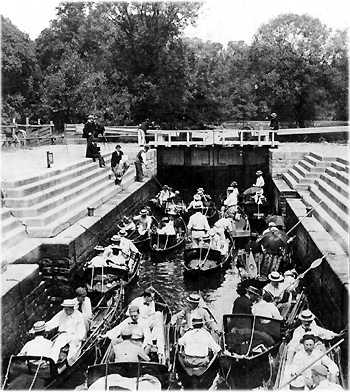 Romney Lock - A summer view in
the 1890s
Romney Lock - A summer view in
the 1890s
from an original stereoview
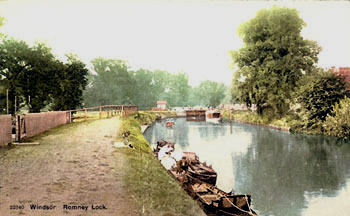 The approach to Romney Lock in
the early 1900s.
The approach to Romney Lock in
the early 1900s.
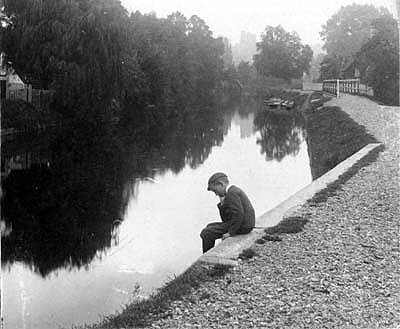
The same area of the Lock Cut in
the early 1900s, looking upstream towards Windsor and a pensive
schoolboy sits on the bank.
Windsor Castle is just visible in the distance.
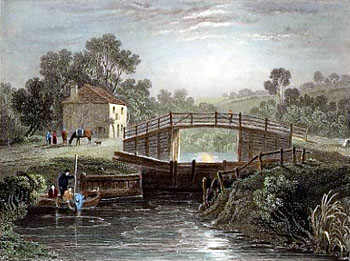 An engraving of a lock, in this
case at Old Windsor, from the 1840s
An engraving of a lock, in this
case at Old Windsor, from the 1840s
An Introduction to the
Worklngs of a Lock
Locks are the means whereby river traffic can move between
the different levels of one river reach to another, either lifted
to a higher reach or lowered to the next, past each weir. All
locks comprise a main stream, fed by water tumbling over the
weir, and a 'lock cut' for navigation. These were all, in the
main, man-made several centuries ago. Romney Lock dates from
the 1790s.
Weirs are designed to maintain river levels regardless
of how much water is in the river system. They are primarily
intended to provide a constant river level for navigation in
times of drought and flood. When very little water is flowing,
the weir slows down the amount of water passing down into the
next 'reach' or section of river, whilst in times of heavy rain
or a winter thaw, significantly larger volumes of water can be
passed on downstream.
Controlling the Flow of
the River
By raising and lowering the various sluice
gates at the weir, the flow of water down the river is carefully
controlled. In past times, the lock keepers would keep in touch
with their colleagues up and down stream to ensure a constant
and controlled flow, although these days automation and centralised
control has been introduced.
It is only in times of severe flood that
the system will be unable to cope, because, once the valley is
full, it is full, and no amount of human engineering can prevent
flooding if water flow is massively increased, as can happen
following extended torrential rain throughout the valley for
weeks on end, or if a sudden Spring thaw releases the stored
up waters of the Winter snows, as was the case in March 1947.
See The
River Thames Floods Windsor in 1947.
At times of high water flow in the river
system, extra sluices can be opened in the weir to pass more
water downstream. In times of drought, water can be held back
to ensure the river remains sufficiently deep for navigation.
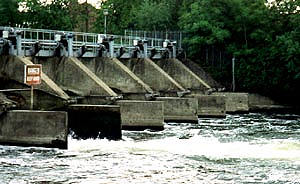 The Weir Sluices
The Weir Sluices
In this picture just one, central sluice gate is open.
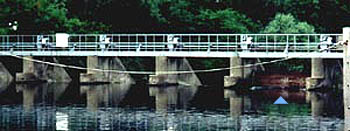 The Weir Sluices from upstream
The Weir Sluices from upstream
To the right, one sluice can be seen raised (open), marked with
a blue arrow

Here the sluice gates are closed
with just a small flow of water over the top maintaining the
river level upstream.

Water level monitor.
The level of each reach is monitored so that adjustments can
be made to water flow throughout the system
There is a limit to the amount of water
that the system can handle. In the Windsor area, a maximum flow
of 275 cubic metres per second can be accommodated. Any additional
water MUST backup, causing a flood. The degree of flooding is
directly related to how much extra water is flowing into Windsor
reach and for how long, both from upstream and from the smaller
streams that drain the valley on either side. In recent years
a peak of almost 350 cubic metres per second was experienced
in February 1997 and the river level rose several feet. The worst
flooding that Windsor has experienced was in March 1947, see
The River
Thames Floods Windsor in 1947. In recent times high water
levels were also experienced at New Year 2003 both upstream of
Maidenehad and down stream of Windsor, but both these towns were
protected by the newly completed Flood
Relief Channel. See also our Story
of the Floods of 2003.
How Locks Work
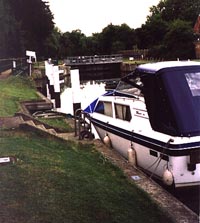 The Approach to
Romney Lock from upstream
The Approach to
Romney Lock from upstream
(The 'Lock Cut')
Weirs and their associated locks are in
effect 'steps' in the river as it flows to the sea. With lock
gates at each end, boats traveling upstream, for example, would
enter the lock when it is 'empty' (at the level of the lower
reach). When the gates are closed the lock is filled, and the
river traffic lifted by the pressure of water from upstream.
When the level of the lock is the same as the upstream level,
the higher gates can be opened and boats can proceed on their
way.
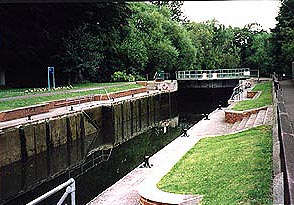 The empty lock
The empty lock
The downstream gates are closed, ready to fill the lock
This sudden demand on water to fill the
lock causes the level directly upstream of the lock to fall temporarily
by several inches, and at Romney Lock a small 'waterfall' adjacent
to the lock has been seen to temporarily stop flowing as water
is redirected into the lock.
Once the lock is filled, in about 6 minutes,
the upper gates are opened and the boats proceed. At this point
vessels travelling down stream can now enter the lock and be
lowered to the next reach by emptying the lock.
When the sluice gates are first opened,
especially if they are opened a little too enthusiastically initially,
the in-rush of water is quite impressive. Indeed boats can be
damaged unless care is taken. It is for this reason that the
sluices are only partially opened at first, and not fully opened
until the level within the lock has risen significantly and the
pressure differentials are less so water turbulence is reduced.
Similarly, care must be taken that all craft within the lock
are free to rise with the water level. If a vessel is trapped
or restrained in any way, perhaps by the bow or stern being wedged
in the structure of the lock gates themselves, it is possible
for the water to rise sufficiently to pour into the boat and
sink it!
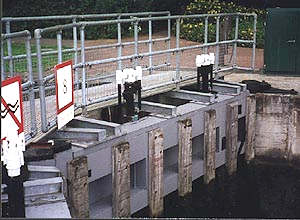 The massive gates and sluice gate
lifting gear (hydraulic).
The massive gates and sluice gate
lifting gear (hydraulic).
In this picture the sluices are down (closed).
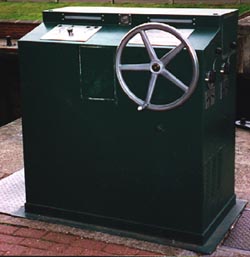
The controls for the lock. A similar
controls are positioned at the opposite end of the lock. The
large wheel opens the gates when the water level on both sides
is equal. To the side are the sluice controls, to fill the lock
from the upstream level, or to empty the lock into the downstream
reach.
Romney Lock Dimensions
Length 257 feet 7 inches (78.51 metres)
Width 24 feet 5 inches (7.44 metres)
The Flood Relief Scheme
for Windsor and Maidenhead
We have included on The Royal Windsor Web
Site an article about the Flood Relief Scheme which is designed
to increase the river's capacity from above Boulters Lock in
Maidenhead, to below Black Potts Railway Bridge, downstream of
Romney Lock. This scheme is designed to accelerate the transfer
of water from above Maidenhead to below Windsor, bypassing the
several notorious river bottlenecks such as Windsor Bridge and
Black Potts Bridge.
Whilst Windsor has not suffered a major
flood since 1947, they are not a rare occurence. Indeed, studying
earlier records shows a pattern of significant flooding every
twenty years or so... we have just been lucky! Without wishing
to appear pessimistic, it can only be a matter of time, and it
is best that Windsor residents are fore-warned - and fore-armed.
Background to The Flood Relief Scheme for Windsor
We would welcome additional material and
comment on this subject.
We have also prepared an article about
the major flooding of Windsor in March, 1947, based on the extensive
knowledge of Gordon Cullingham who was closely involved throughout
the event. His comments are worthy of note.
Index to more
River Thames stories

To contact
us, email Thamesweb.
|